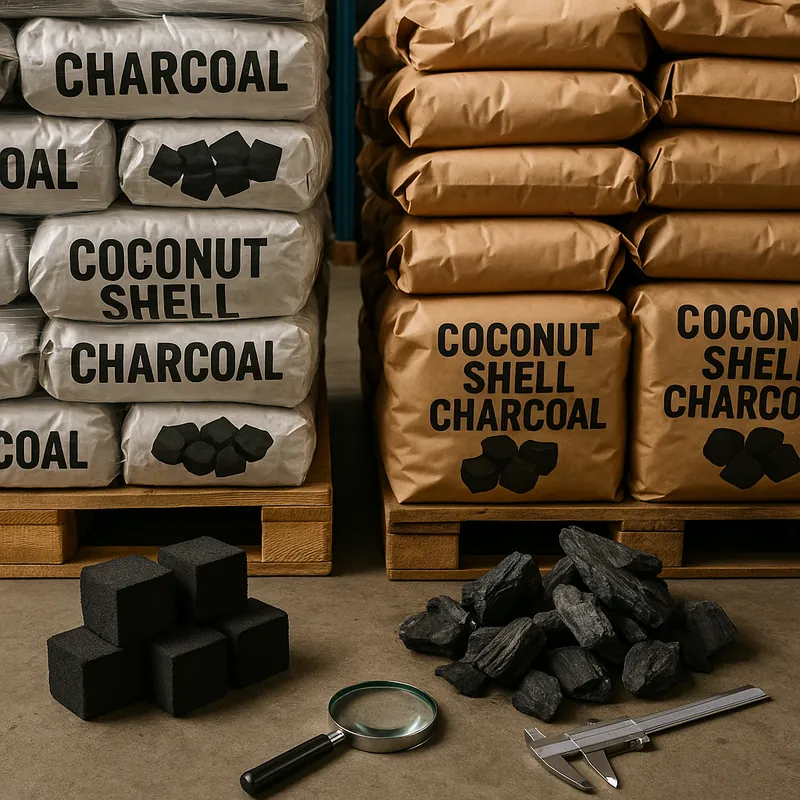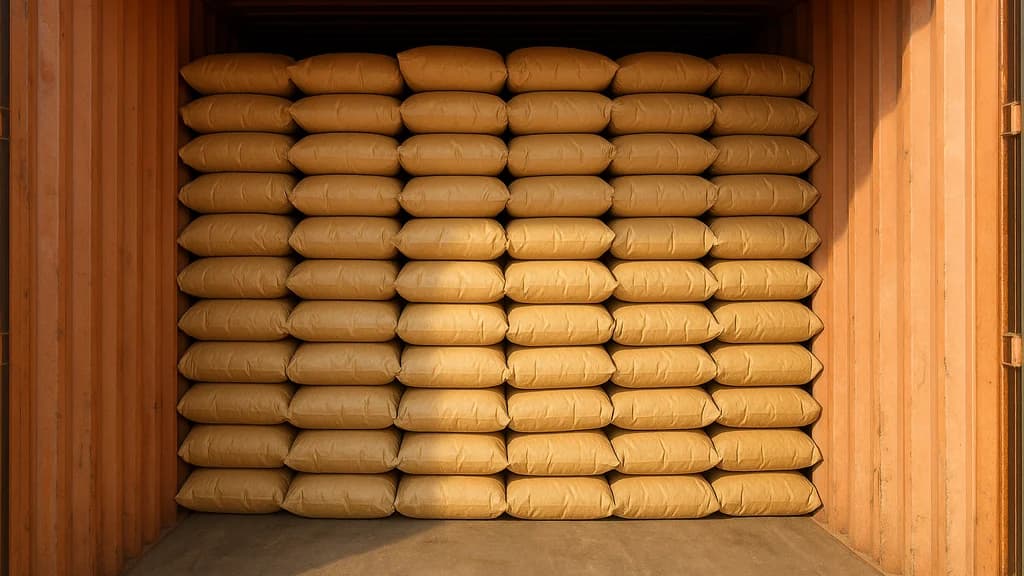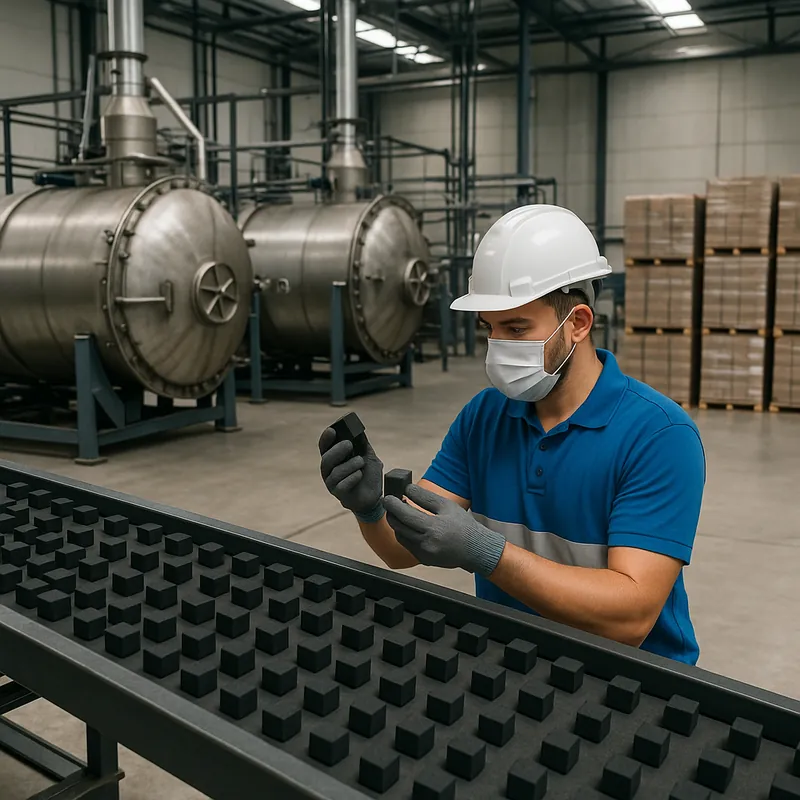Get beyond marketing and vet private label charcoal suppliers by spec, QC, and sourcing. See real MOQs, costs, and tests so you can launch a premium SKU.
The Short Answer
Yes—private label charcoal can be truly premium. The trick is choosing the right material, locking the right spec, and holding your supplier to it at scale. In our experience, coconut shell briquettes are the easiest path to consistent “premium” performance (low ash, long burn, high heat), while hardwood lump wins on the artisanal story if the sourcing is verified and the size grading is disciplined. Expect MOQs around one 20-foot container per SKU and packaging print MOQs of 3,000–10,000 bags. Typical ex-factory costs range from $0.95–$1.50 per 1 kg bag for premium coconut briquettes and $9–$17 per 10 kg bag for premium lump, depending on spec and volume. If you want the short playbook: define a strict spec, test it, demand batch COAs, and build your brand around packaging, traceability, and certified sourcing.
What You Need to Consider
Can private label suppliers really hit premium quality?
They can—if two things are true: the feedstock is consistent and the process is controlled. For coconut shell briquettes, premium specs we see retailers anchor on are:
- Moisture ≤5%
- Ash 1.8–2.5%
- Fixed Carbon ≥80–85%
- Minimal smoke/odor, strong cube integrity
For hardwood lump charcoal:
- Moisture ≤5%
- Ash ≤2–4% (species-dependent)
- Fixed Carbon ≥75%
- Size grading: e.g., 40–120 mm with fines under 8–10%
- No off-spec woods, no stones or scrap, minimal popping
Ask for third-party tests aligned with EN 1860-2 for BBQ charcoal and briquettes, or ISO-based methods (18122 ash, 18134 moisture). Then pressure-test samples in your exact use case.
How do you choose between lump, briquettes, or both?
- If your brand story is precision and consistency, coconut shell briquettes are your friend. Long burn, low ash, and stable heat are easier to standardize. Our BBQ Coconut Shell Charcoal Briquettes are built around that idea—4–6 hours burn time, high heat, low ash—ideal for premium retail or restaurant supply.
- If your audience craves “pure hardwood flavor,” private label lump works—provided the supplier is disciplined about species, sizing, and FSC-certified sourcing.
- Serving hookah lounges or specialty retail? Consider a dedicated shisha line. Our Shisha Charcoal prioritizes fast ignition, long session length, and low smoke—exactly what that market cares about.

Many brands start with one hero SKU, then expand. Trying to launch lump, BBQ briquettes, and shisha all at once stretches your QC and cash.
What about MOQs and costs?
Here’s a realistic starting point:
- Volume: One 20-foot container per SKU (briquettes ~16–19 MT; lump ~12–15 MT depending on density).
- Packaging print MOQs: 3,000–5,000 bags for flexo; 10,000+ for gravure; 1,000–2,000 for retail cartons (shisha).
- Cost benchmarks (ex-factory/FOB, premium spec):
- Coconut briquettes: $900–$1,300/MT → roughly $0.95–$1.50 per 1 kg bag depending on packaging.
- Hardwood lump: $450–$850/MT → roughly $9–$17 per 10 kg bag, driven by species and FSC chain-of-custody.
- Lead time: 2–4 weeks production after artwork approval, plus packaging procurement (1–2 weeks), plus transit (3–6 weeks to EU/US). Freight has been volatile this year, so bake in buffer.
Which certifications actually matter?
- FSC for lump charcoal and any wood-derived inputs. If you’re selling “sustainably sourced,” FSC-certified chain-of-custody is what buyers ask for.
- EN 1860-2 compliance for European retail.
- ISO 9001 for quality management; ISO 14001 for environmental management.
- For shisha and food-service channels, extra credit for clean-room handling or ISO 22000/HACCP around packaging areas.
- Regulatory trend to watch: EU deforestation rules are tightening upstream due diligence. If you’re building a wood-based premium brand for Europe, prepare for more traceability requests. Coconut shell briquettes are advantaged here since shells are an agricultural byproduct.
What packaging positions your brand as premium?
We’ve seen three levers work:
- Barrier packaging to control moisture (laminated kraft or PE-lined bags). Charcoal is hygroscopic; packaging is performance insurance.
- Smart sizes and handles. 2–3 kg for retail convenience; 5–10 kg for BBQ enthusiasts; 1 kg carton for shisha. Ergonomics matter more than people admit.
- Story and traceability. QR-coded batch numbers, FSC logos where relevant, and clear specs on the bag. Premium buyers want proof, not adjectives.
Practical takeaway: define your spec on a one-page sheet, align packaging to protect that spec, and put your proof on the bag.
The Reality Check
What can go wrong with private label?
- The “golden sample trap.” The lab sample looks perfect; the container is average. Avoid this by writing your spec into the contract, tying payments to pre-shipment inspection, and requiring a COA for each lot.
- Ash creep and moisture drift. Monsoon season and humid warehouses will show up in your ash and moisture numbers. We add desiccants in containers and specify barrier bags for coastal markets. You should, too.
- Sourcing shortcuts. With hardwood lump, mixed species and uncarbonized pieces sneak in if grade control is lax. Ask for sieve analyses and a size-distribution report; include max fines and spark limits.
- Packaging scuffs and burst seams. Low-cost bags fail on pallets. Request drop tests and seam-strength specs. Specify pallet pattern, corner boards, and stretch-wrap gauge.
- Freight and timing. The last six months have been choppy on ocean freight. Build a rolling forecast and reorder when you’ve sold 50–60% of on-water volume.
Can you really guarantee low ash and long burn?
Guarantee is a strong word, but you can manage to it:
- Tie specs to test methods. “Ash ≤ 2.5% by ISO 18122.” No ambiguity.
- Insist on batch-level COAs and retain samples. A good supplier will share lab photos, not just numbers.
- Do side-by-side burn tests. For briquettes: weigh equal charges, measure time-to-peak and time-to-extinguish on a standard grill. For shisha: test 26 mm vs. 28 mm for session length and heat stability.
- Control what happens after production. Moisture spikes post-production are common. Warehousing and packaging choices are part of quality control, not afterthoughts.
White label vs private label vs contract manufacturing—what’s the real difference?
- White label: fastest to market; your logo on a factory’s standard spec and standard packaging format.
- Private label: your branding and your spec (size, density, ash target), within the factory’s capability.
- Contract manufacturing: you own the formula/recipe details and often the packaging tooling; the factory produces strictly to your SOPs.
Most premium brands we support sit in “private label with bespoke spec” territory. It gives you differentiation without reinventing the production line.
Practical takeaway: write your spec like you’ll need to defend it to a buyer—numbers, tolerances, test methods, accepted ranges, and remedies.
Your Best Move
So, how should you start?
If you’re launching a premium brand with private labeling, we recommend:
- Start with one hero SKU. Coconut shell briquettes for BBQ are the easiest win for retail or e-commerce because they’re consistent and test well. Our BBQ Coconut Shell Charcoal Briquettes are a common starting point for this reason.
- If your channel is hookah lounges or specialty tobacco, lead with a shisha cube (26 or 28 mm) and add BBQ later. See our Shisha Charcoal for reference specs.
- If you have strong access to BBQ specialty stores and want the “natural hardwood” angle, launch FSC-certified lump. Make size grading your differentiator.
What to do next:
- Define your spec on one page. Include ash, moisture, fixed carbon, size grading, packaging, and test methods.
- Request two sample rounds: lab-confirmed and pilot-production. Test them in your exact equipment.
- Agree QC checkpoints: incoming raw material checks, in-process carbonization temp logs, final COA, and pre-shipment inspection with AQL sampling.
- Lock packaging: barrier materials, handle design, pallet pattern, and print MOQs. Approve a die-line and color proof.
- Start with one container, one SKU. Track performance, collect customer feedback, and reorder before stock-out.
- Build your proof: FSC (for lump), EN 1860-2 compliance, batch QR. Make your sustainability story verifiable.
If you have questions about The Role of Private Labeling in Building a Premium Charcoal Brand or need expert guidance, contact our team.
Final takeaway: premium private label charcoal isn’t about louder marketing—it’s about disciplined specs, verified sourcing, and consistency from sample to container. Nail those, and your brand earns the “premium” label every single burn.



